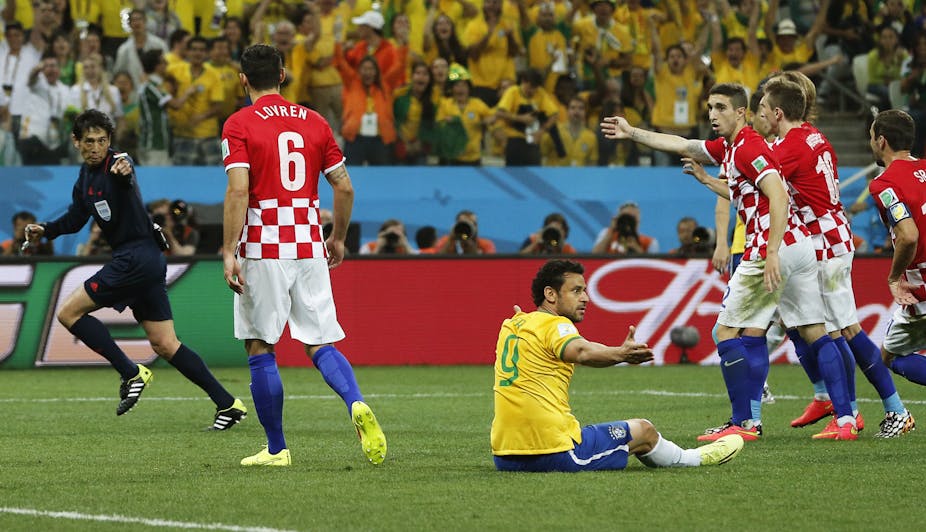There has been much hand-wringing over the problems that World Cup players are facing due to the environmental extremes they are exposed to in Brazil. There has been little sympathy for the men in black, but the effects on them can look more severe.
The suggestion has been that the high temperatures pose a significant health risk, may affect the quality of play and slow the tempo of games. FIFA has taken some steps to combat this, such as later kick-offs in the more northerly venues and outlining criteria in which cooling breaks will afford players time in each half to take on fluids.
However, England’s first match, against Italy in Manaus, saw temperatures hit 30 degrees centigrade with humidity at 61%. Some players were seen suffering heat cramps, and others were affected in less obvious ways. Italy’s Claudio Marchisio said after the match: “At times it felt like having hallucinations due to the heat.” But it is not just the players who are exposed to high temperatures and still have to perform – the referees and their officiating team are in exactly the same conditions, yet the quality of their performance is still expected to be world class.
Players can be supported by team-mates following periods of high exertion, but a referee is afforded no such luxury. Some may qualify this by thinking that in physical terms, the referee’s game is less demanding than a players. Well, let’s break that down.
Going the distance
Research suggests that at the elite level, the total distance covered by a referee in a single match is in the region of 12km, of which 889m is at high speed (above 19.8 km/h) with approximately 30 full sprints (above 25.2 km/h) over the 90 minutes. This is a significant physical demand, perhaps even more so than the players, particularly given that referees are on average 10-15 years older and so the relative metabolic strain is greater for a given physical load.

Consequently, there is no doubt that the referee must be physically fit and, to assess this, performance tests are a prerequisite for qualified referee status. The ability for the referee to cover ground is paramount, because failure to keep up with play can leave the ref away from the action and less able to make the crucial calls at the right time. The referee’s ability to get key decisions right is inextricably linked to their ability to stay close to where incidents occur, and this is partly determined by their physical fitness.
The physical demands of the game are exacerbated by the climatic conditions (in the same way as for players), so it is entirely expected that the referees’ physical performance may be affected in Brazil just as the players will be. Perhaps this has already been evident, with a glut of controversial decisions already made in a number of games.
The physical demands of a referee are often ignored at the expense of their role as decision makers – the referee’s game is often seen as cognitive rather than physical. But while the cognitive element of their game receives attention, the sheer scale of this task is perhaps overlooked. It is easy to criticise a decision from your living-room armchair, whilst watching in slow motion during a close-up replay. But this is because it is easy to concentrate hard a handful of times, for shorts periods when you are not running 12km in 30 degree heat. A referee must have complete and uninterrupted concentration for 90 minutes, during which they may have to make between 200-250 “foul/no foul” decisions and 75 “out of play” decisions.
Decision time
Many of these decisions are made more difficult through a lack of objective criteria (modest agreement rates between 60-85% have been observed between “expert” panels and in-situ decision making), and can be affected by other factors such as crowd size, the reputation of the teams, prior decisions made and physical stature of the players. For the next game you watch, try concentrating on calling every potential referee decision for the whole match – it is mentally exhausting.
Unsurprisingly, the problems associated with exercise in the heat will also negatively affect referee’s decision making. It has been shown that increased core temperature (which would be expected to occur in referees during world cup games in the heat) can exert a negative effect on psycho-motor speed, visual processing and working memory.

It could be argued that if the hot conditions in Brazil reduce the tempo of the game, then the demands on the referee will also be less and so decision making should not be compromised. However, only moderate relationships have been found between the amount of high-speed running completed by a referee and the mean distances completed by the players. Far better correlations are found between distance covered by the referee and the total distance travelled by the ball. Therefore, the tactics employed by teams will have a direct effect on the work done by the referee, which may consequently affect the referees’ decision-making performance. Thus, a game which is played at one of the hotter venues, by teams which favour a direct approach (leading to increased distances travelled by the ball), may well yield a greater amount of controversial decisions.
So, while we may afford the players some leniency on their performance in these difficult hot conditions, referees must often work relatively harder than the players, in exactly the same environmental conditions. They must always keep up with play and concentrate fully for every minute of the match whilst making game-changing decisions using limited objective criteria. So cut them some slack – unless of course it’s your team that suffers from an atrocious decision in the last minute of injury time.

